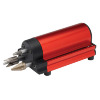I was discussing, with a meat world friend, trimming some handgun brass (.38Spl) for the upcoming competition season and an odd topic came up that I hadn't really given much thought. (If you don't believe in trimming handgun brass, don't judge...it isn't constructive and doesn't address the question being asked).
For the purpose of this discussion, let's use these definitions (I know the terms are used almost interchangeably, but they are different)
1. Bevel - the slope added to the inside of the case mouth
2. Chamfer - Breaking the edge on the outside of the case mouth
After you trim the case, do you bevel or do you chamfer the case mouth first?
I'm aware that it is a bit like asking if you brush of floss first, but I was just curious if folks have a decided preference
For the purpose of this discussion, let's use these definitions (I know the terms are used almost interchangeably, but they are different)
1. Bevel - the slope added to the inside of the case mouth
2. Chamfer - Breaking the edge on the outside of the case mouth
After you trim the case, do you bevel or do you chamfer the case mouth first?
I'm aware that it is a bit like asking if you brush of floss first, but I was just curious if folks have a decided preference


